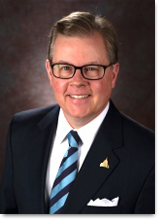
The 2019 ACI-NA Annual Conference and Exhibition isn’t over yet! We have a lot more in store for you today. Airport decision makers and their peers come from across North America each year to attend our signature event, and explore the latest trends and strategies to stay ahead of the curve.
Yesterday’s sessions were very thought provoking and included a wide range of topics from innovative leadership solutions, organizational structure, airport construction, financial resiliency, to 21st Century passenger processing. Today, attendees will get to dive into sessions featuring topics promoting security, the latest regulatory updates, changing aviation risks, and much more.
And let’s not forget about tonight’s closing event. Ever been to Havana? One of the stops for the evening event includes a Havana street party where you will be greeted with traditional Cuban street food, energetic music and vibrant colors that will awaken all of your senses. I look forward to seeing you all there!
Warmest regards,
Kevin M. Burke
President and CEO, ACI-NA
|
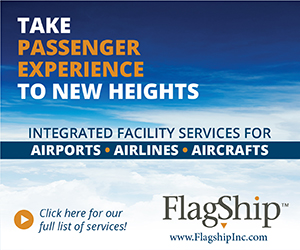

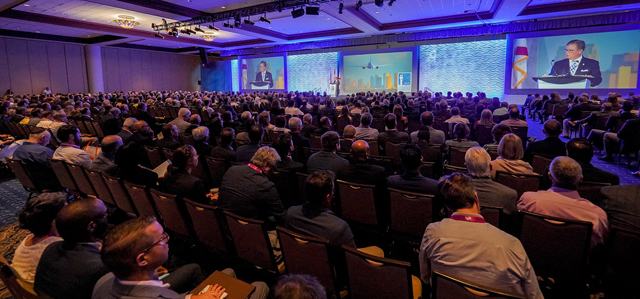
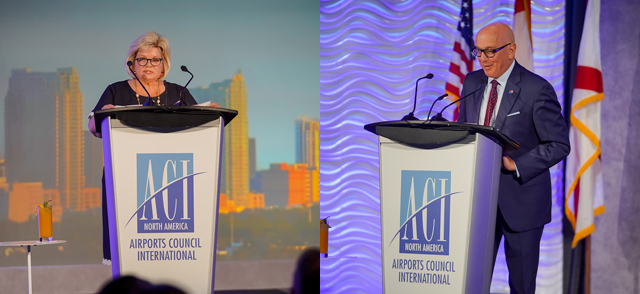
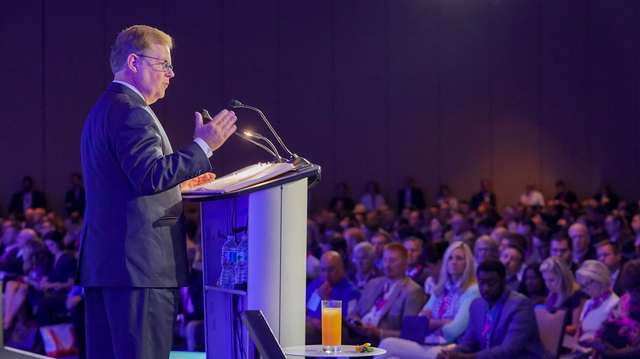
“There is power in the collective.” This statement by Candace S. McGraw, Chair, ACI-NA, during her welcome note at General Session 1 on Monday summed up both ACI-NA’s relationship with its members and the power of the relationships members have with each other. This is an organization that continues to grow its position, she added, because of the positive benefits that airports bring to their communities: through innovation, sustainability and workforce planning.
Joseph W. Lopano, CEO at Tampa International Airport, also welcomed conference attendees. “Just try to enjoy yourself,” he said, as he took a sip of his Spirit of Flight, “our own drink” at TPA, which “just happened” to be sitting on the table next to the podium. He stressed how important it is for airport directors to have a lot of common sense. “You can observe a lot by watching,” he said, quoting Yogi Berra. Tampa Mayor Jane Castor, who has been living in and observing Tampa her whole life, agreed. “This city is going to change more in the next decade than it has in my entire lifetime.”
Later, Kevin M. Burke, President and CEO, ACI-NA, took the stage and got everyone’s attention right away with the stats that he shared about passenger growth last year: volume is up 5% and is at 2 billion passengers. “There are no shortages of challenges and opportunities for everyone in this room,” said Burke, our own “Airport Man.”
Burke outlined some of the many successes the industry has seen over the past year, such as real estate and land-use projects and international transport progress. “I’m happy to report, we’ve had a lot of success,” he said. “That’s what I like to do, move that needle forward.” He also mentioned some of the ongoing projects, such as infrastructure needs, security, congestion, connectivity, security staffing shortfalls, biometric programs, drones, napping pods and sensory spaces. And while some of these may seem like small changes, they equate to airports addressing innovation and ingenuity, he said. He contributes the successes to the people in the industry who are willing to step up. “You, folks, are the reason for our success.”
And, in closing, he enthused: “I only have one gear, and it is forward. Let’s get to work!”
Click here to read ACI-NA President and CEO Kevin Burke’s full state of the industry address.
|
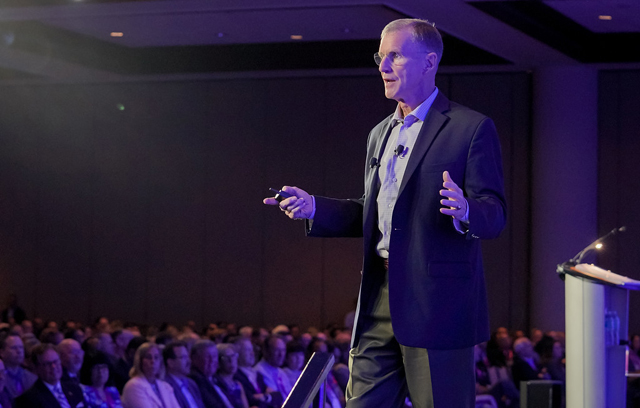
From some insightful looks at the how space flight finally achieved success to some behind-the -scenes peeks at what goes on in a 4-start general’s mind during a war, General Stan McChrystal had the conference crowd riveted during his hour-long keynote on Monday. But, for someone so accomplished, who has led troops into battle and made life-and-death decisions for thousands – if not millions - he was surprisingly down-to-earth. “The world teaches you humility,” he explained.
His comparisons and examples were so varied, that if one didn’t quite reach you, the next one would be crystal clear. For example, when it came to initial attempts at space launches, it wasn’t that any particular piece was bad, he said. It was that they didn’t all connect together seamlessly. It was the thought-process of George Mueller, a systems engineer who came into the Apollo program, that connected the pieces. He made sure that everyone understood the entire entity. Only in the context of the whole can you understand, McChrystal relayed. It is critical to success. Mueller called the success a “mundane art of management,” though McChrystal said he would add “leadership” to that as well.
He then used Frederick Winslow Taylor to illustrate how there was “one best way” that led to massive improvements in manufacturing efficiency. Then, he followed that up with an example of how efficiency is being trumped by adaptability and how “we are going to need wisdom” to conquer that one. It won’t be the kind of wisdom flowchart that we are used to, though. “Wisdom used to reside at the top,” he said. “That is not true anymore.” He said things change too fast and things shift, which is an important, life-changing concept he learned during his command of the Joint Special Operations Command. In order to beat the Al Qaeda terrorists, we had to change how we operated, he said. “For two years, they were defeating us because they were different.”
These concepts apply to organizations as well, including ACI-NA. He said the answer is to understand ourselves and where we fit in. Take, for example, a spear. It is not the tip that is dangerous; the lethality comes from the power in the shaft, which is made up of many parts/people. “How does it all come together?” he asked. “It comes together with leadership… The key is leveraging uncertainty.”
|
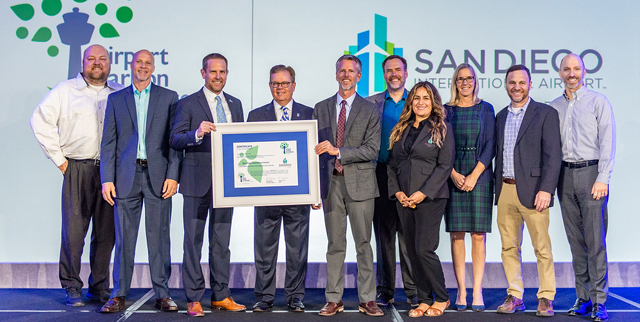
Yesterday, Airports Council International – North America (ACI-NA) recognized the five-year anniversary of North American airports participating in the Airport Carbon Accreditation program. The Airport Carbon Accreditation program recognizes airport efforts to manage and reduce their CO2 emissions through independent assessment and verification. Notably, San Diego International Airport was recently accredited as North America’s second-ever carbon neutral airport. ACI-NA recognized the 47 North American airports that achieved Airport Carbon Accreditation throughout the past year at the 2019 ACI-NA Annual Conference and Exhibition. Read more >>
|
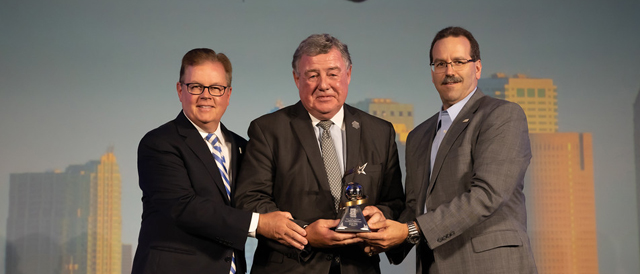
Airports Council International-North America (ACI-NA) announced that James (Jim) Cherry has been named the recipient of the 2019 Williams E. Downes, Jr. Memorial Award. The Downes Award, the highest honor given by ACI-NA, is presented to an individual who has demonstrated outstanding leadership in promoting the cause of airports and aviation throughout the local, national and worldwide communities. The award was presented during a special ceremony at the 2019 ACI-NA Annual Conference and Exhibition in Tampa, FL, on Sept. 16. Read more about Jim Cherry in our Centerlines article.
|
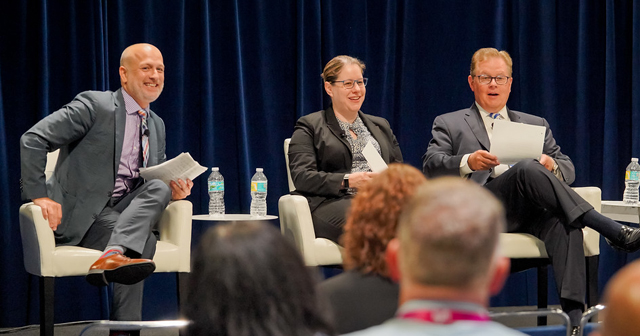
From possible routes that government legislation might take to the potential results of upcoming elections, the session on U.S. and Canada government affairs took a deep dive into the current political landscape. These anticipated projections made you really stop and think about where we are headed.
This session was moderated by Kevin M. Burke, President and CEO, ACI-NA, and featured speakers Daniel Robert Gooch, President, Canadian Airports Council, and Annie Russo, Senior Vice President of Government and Political Affairs, ACI-NA. All three discussed government involvement in airports, with Burke and Russo focusing on the U.S. side and Gooch shedding some light on the Canada one. All three concurred that maintaining the safety and the security of the traveling public is of paramount importance and that securing the funding to do so and to maintain the facilities is another. On the legislative side, USMCA (or NAFTA2) is also a major topic that is something of interest to both U.S. and Canada, said Russo.
Russo also summarized some issues specific to the U.S. government, starting with the general statement that “U.S. politics, at the moment, are pretty complicated.” On top of the list of issues at the moment are gun control, impeachment, judicial nominees, security and, you guessed it, PFCs. Kevin explained, “We will get this done at some point….We are trying to convince them that this is good for America.” Russo added that Congress has decided to increase those fees but divert them. It would be great for TSA and CPB to get more of the money back to allow for more staffing, equipment and to enable our airports to move forward, she said.
Specifically on the Canadian side, Gooch explained the problems with CATSA. “The funding organization has been broken,” he said. However, on March 19 it was decided to convert it to a nonprofit organization with an ambitious completion date of April 1, 2020. He also touched on climate change impacts, flight shaming and infrastructure funding that has been stuck at $38.5 million for 20 years. “When you have to beg for money every year, you can’t run a business that way,” said Gooch. He also broached the anticipated status of the Green Party and the National Democratic Party (NDP) in the next election.
|
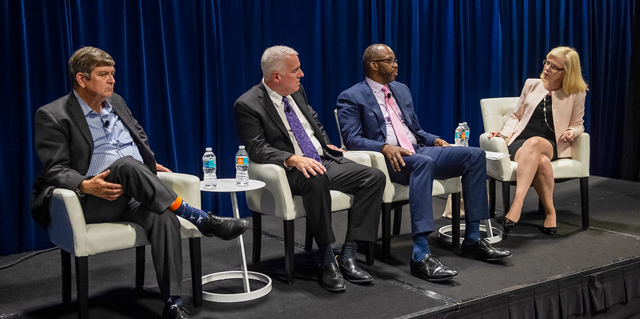
“As a leader, you have to have courage,” said Huntley A. Lawrence, Director of Aviation, Port Authority of New York and New Jersey, during the “Aligning Organizational Structure to New Demands” session on Monday. In addition, “our leaders have to be flexible and adaptable.” It is a very difficult and complex game, he said. This is especially true when it comes to how you respond to changes and how you deal with pressures at the airport, said moderator Joyce F. Carter, President & CEO, Halifax International Airport Authority. And you shouldn’t follow other airports, added Joe Nardone, President & CEO, Columbus Regional Airport Authority. You should find your own ways to drive change on a daily basis. “We will do whatever it takes to find solutions,” said Nardone. “We are a little creative and a little aggressive and we aren’t afraid to take chances.”
PANYNJ proved they were capable of exactly that, as well, when they embarked on their massive $30 billion worth of investments. “We had to look at ourselves and who we were as an organization,” said Lawrence. “We were basically landlords” and we had to look at being a top-notch airport operator, he added. They started with consolidation, then looked at everything holistically and brought in a consultant, which meant they had to be willing to dip their toes into being measured and judged, and had to be willing to communicate when they weren’t making the cut, said Lawrence. They also looked for “solid leaders” as they realized that “the engine of your organization is your people.”
Nardone also places a lot of value on staff. He suggested going out into the terminals to get in touch with what is going on with employees and with passengers. When initiating change, that is especially important. You have to have a plan, you have to communicate the plans and you have to power through, he said. “Ultimately, it is in everyone’s best interests to have dialogue.”
Tom Ruth, President & CEO, Edmonton Airports, feels similarly. What is important to me is knowing what my people want as far as organizational change, he said. It is the third, and most important, step when incorporating change: “Make sure you effectively communicate the change throughout the organization” and understand how the change will lead to long-term success, he said. The first two steps are looking at the strategy and then going through the entire organizational structure to see how the change will affect everyone. “The biggest skill we have at airports is… how we deal with change.” Our airport leaders have to be able to “’get their hands dirty,” be honest, continue to ask why and know when it is time to make the hard decisions so everyone is driving in the same direction.
|
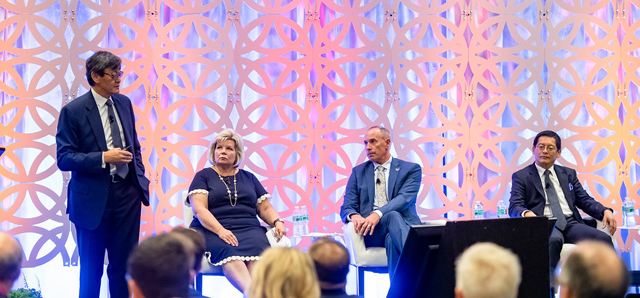
The subject of this session held on Monday “is something that is consuming a lot of time in the industry,” said moderator Candace S. McGraw, Chief Executive Officer, Cincinnati/Northern Kentucky International Airport: the passenger processing experience. But will a “happy passenger” and “airport” ever be entirely possible? Maybe not, because you cannot please everyone. But, after seeing and hearing about some of the amenities and processes incorporated at these three airports, true passenger happiness might, indeed, be a reality.
The speakers for this session were Brian Ryks, Executive Director/Chief Executive Officer, Minneapolis-St. Paul Metropolitan Airports Commission; Tan Lye Teck, Executive Vice President, Airport Management, Changi Airport Singapore; and Howard Eng, President and Chief Executive Officer, Greater Toronto Airports Authority. Each provided an overview of the types of initiatives they’ve taken to improve the passenger experience and some of the reasons behind their actions.
At Minneapolis-St. Paul, first they put together a top-notch staff then focused on their leadership strategy, all before progressing to the next steps: goals and focus areas. Ryks said they established their goals as: Safety, Security, Preparedness, Economic, Air Service, Talent, Innovation, Customer Service and Engagement. Their three focus areas became: (1) Develop new strategies to enhance financial strength; (2) Grow stakeholder and community engagement; and (3) Deliver a seamless ‘one journey’ experience for MSP passengers. Then they got to work. They implemented a parking reservation program, are building a new 5,000-space parking structure and are testing out a parking guidance system. They also worked on security passenger flow monitoring via Xovis, concessions updates such as adding grab and AtYourGate, point-of-sale data integration, biometric exit technology with Delta, and passenger flow and business intelligence.
When Teck described The Changi Experience, not only were the numbers jaw-dropping, so were the photos and video. In 2018, they had 65.6 million passengers, 386,000 total aircraft movement, 221,155 passengers on Dec. 21 and an average of 7,400 flights every week. “Every day we bring something interesting,” said Teck about their secret. “We try to go to the basics of understanding our customers.” He said this means making sure passengers don’t miss their flights, helping them from being separated from their luggage and making the flow of the airport intuitive. “We think passengers should have a clear, simple, intuitive way of finding things.” They also strive to make sure passengers feel happy on their journey through the airport. “We tried to make technology less intimidating and made it a shape and form that is easy to like.” At Jewel Changi Airport they even have a waterfall and indoor garden, a canopy park, slides and hedge mazes!
At Toronto Pearson, Eng said they have found that technology makes the process go quick and faster, “but at the end of the day, people are people.” At Toronto Pearson, they had 49.5 million passengers in 2018, so they have had a lot of opportunities to see what makes the passengers happy. “Our focus is FLOW,” he said. “We have to make the flow seamless for them.” They are also starting a known traveler digital identity program next year and have incorporated ACD-M, which allows everyone to share the same database. Signage is important to them too. “We are all working on signage,” Eng said. In this industry, we need high-tech and low-tech. “You don’t want the passengers getting lost.”
|

Is your airport ready for the next economic downturn? Chellie Cameron, CEO of Philadelphia International Airport, led a discussion with three of North America’s leading airport directors on how U.S. and Canadian airports dealt with the last economic downturn, and what necessary steps there are to take to prepare for the next recession. St. Louis’ Rhonda Hamm-Niebruegge, Tampa’s Joe Lopano, and Kelowna’s Sam Samaddar dived into the key strategies and best practices available to assist airports in building their toolkits for financial resiliency.
Building cash reserves in preparation for times of uncertainty is important when navigating toward a better situation. Saving for a rainy day and being vigilant about disruptions at the airport is a part of the main strategies for protecting your revenue.
However, each of the panelists agreed that the first step in your plan for the best path forward through a financial decline has to include communication. Airport leaders must be transparent with staff, tenants and the surrounding communities in order to make progress. Nothing happens overnight, especially without nurturing your relationships and getting creative.
“Be thoughtful, but don’t panic. Building relationships when the times are good is crucial. When things go south, they will come to your aid,” Lopano said. “The time to prepare is now. ”
|
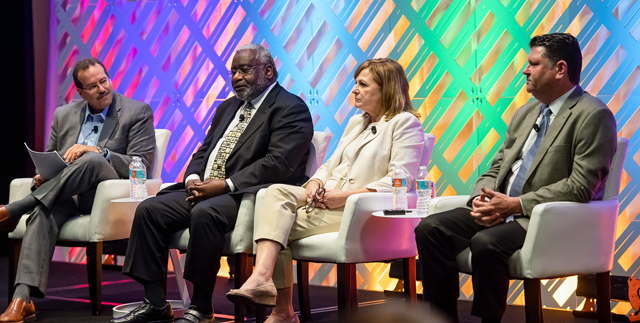
ACI-NA Vice Chair Lew Bleiweis led three airport professionals in a discussion on how airports across the U.S. and Canada approach and manage capital projects, particularly infrastructure projects. Los Angeles World Airports’ Robert Gilbert, Paslay Management Group’s Margaret McKeough (formerly of the Metropolitan Washington Airports Authority), and the Port Authority of New York and New Jersey’s Michael Moran discussed using innovative planning and design processes, techniques for managing capital programs, and project delivery strategies to meet the airport’s needs on time, on budget and on quality.
Panelists stressed the importance of organization-wide buy-in and commitment from leadership to drive the project forward and how building in time to focus on what actually needs to be accomplished.
“Have the discipline to make sure that what you have at the beginning is what you want to have in the end,” Gilbert said. “The principles are the same regardless of the size of your airport or the complexity of your project.”
|
 BETWEEN: September 13-18, 2019 BETWEEN: September 13-18, 2019
TO/FROM: Tampa Airport, Marriott, Embassy Suites, Hilton Tampa and the Tampa Convention Center
Before you request your ride, in the “Promos” section of the Lyft app, enter your promo code: AIRPORTS19. Applied credit is displayed on the ride payment screen. Here are the details:
GET THE APP
Download the Lyft app for iPhone or Android . Already have the Lyft app? Go straight to step 3.
CREATE YOUR ACCOUNT
Set up a Lyft account. You’ll need to add a credit card, in case your Lyft rides go beyond the event. Any additional tips will be charged to your credit card as well.
SUBMIT YOUR INFO
Add the code AIRPORTS19 to the “Promo” section of the Lyft app before you request your ride. You must be in “Personal” mode for the code to apply and will only need to enter the code one time.
|
General Session 2 (9:30 am – 10:30 am)
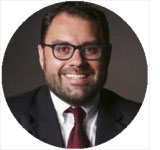 Aaron Sharockman Aaron Sharockman
Executive Director, PolitiFact
Aaron Sharockman is the executive director of PolitiFact, the largest fact-checking organization in the United States. Aaron leads the growth and development of PolitiFact, manages its outreach and news partnerships, and oversees new initiatives and product development. Sharockman has been with PolitiFact since 2010 and served most recently as the editor of PunditFact, a website dedicated to checking claims by pundits, columnists, bloggers and the hosts and guests of talk shows. He was a 2016-17 Reynolds Fellow at the University of Missouri and taught a class on political fact-checking at the University of Missouri School of Journalism.
|
 Managing Changing Risks in Aviation (2:15 pm – 3:00 pm) Managing Changing Risks in Aviation (2:15 pm – 3:00 pm)
Airports of today are faced with an increasingly complex and evolving plethora of risks and challenges, such as unmanned aerial systems, climate change, cyber-attacks and PFAS contamination. How does airport leadership ensure they are focusing on the right priorities? What processes can help review and evaluate not only risks but also opportunities? How do you bring together your staff to solve these issues using a multi-disciplinary approach? In this session, learn about how your organization can be structured to proactively manage today’s risks and be prepared for tomorrow’s unknowns.
 North American Aviation Security Dialogue (3:15 pm – 4:20 pm) North American Aviation Security Dialogue (3:15 pm – 4:20 pm)
Evolving threats to civil aviation such as those posed by creatively concealed explosives, large crowds in public areas and unmanned aircraft systems (UAS), present a unique challenge for both regulators and airport operators. Technology is an essential component in enhancing the security of the aviation system. In order to improve security effectiveness while managing budgetary constraints, it is important for agencies and the industry to collaborate on effective processes, procedures and technology. Don’t miss this opportunity to talk directly with senior TSA and CATSA representatives about initiatives to stay ahead of the latest threats.
 The Transnational Regulatory Picture (4:30 pm – 5:30 pm) The Transnational Regulatory Picture (4:30 pm – 5:30 pm)
Join us for this perennial transnational favorite, which provides the opportunity to interact face-to face with senior officials from both Transport Canada and the FAA. In this year’s session, we will be discussing the latest regulatory landscape, reform efforts from both agencies, key policy initiatives and a look ahead. This is always an informative and engaging session and provides a superb opportunity to ask questions and discuss concerns.
|
Be sure to tweet comments and photos while you are at the 2019 ACI-NA Annual Conference and Exhibition. Mention @airportscouncil and use the hashtag #airports19.
|
Just because you’re at a conference doesn’t mean the world stops. Centerlines LIVE will continue providing the latest industry news while Centerlines Today is on hiatus. This section will feature the latest industry news so you don’t miss a beat while networking with old friends and new connections.
>> Hartsfield-Jackson expects a record total of 111 million passengers for 2019
Hartsfield-Jackson International Airport expects to handle a record 111 million passengers for 2019. Last year, a total of 107.4 million passengers passed through Hartsfield-Jackson, making it the world’s busiest airport measured by passenger counts, Airports Council International confirmed Monday with its official traffic report for 2018. Kevin Burke, President & CEO of Airports Council International - North America (ACI-NA) also commented on the growth of North American airports.
>> Funding for Jack Garland airport cleared for landing
Ontario’s government says it is “investing in infrastructure critical to local economic development, retaining existing jobs and creating new employment opportunities. Nipissing MPP Vic Fedeli announced an investment of more than $2.4 million for the Jack Garland Airport to repair and extend its cross-wind runway and approach light system.
>> Senate chairman worried ‘Real ID’ will shock air travelers
A post-9/11 law designed to keep people from using fake IDs to board airplanes is one year away from taking effect, but the chairman of the Senate Commerce, Science and Transportation Committee worries that it’s destined to create “Y2K-type disruption” at the nation’s airports in October 2020.
>> Shreveport Regional Airport sees more flyers this summer
A new flight to Destin, Florida, larger planes and a couple of billboards have helped push more passengers to the Shreveport Regional Airport this summer. Airport officials say this has been their busiest summer since 2000.
>> Airport joins Restaurant Week with ‘Taste of SAN’ event for travelers
San Diego Restaurant Week doesn’t begin until Sunday, but travelers at San Diego International Airport will get a sneak peek with free tastings throughout the day on Wednesday and again on Sept. 26.
>> FAA chief to test out changes to Boeing 737 Max software in simulator
The new head of the Federal Aviation Administration is planning to test out Boeing’s software changes to its beleaguered 737 Max planes in a simulator this week, he said Monday.
Related article: International Panel Set to Criticize FAA’s Approval Process for Boeing 737 MAX Jets
>> Norwegian given time as bondholders accept rescue plan
Norwegian Air Shuttle ASA's bondholders have overwhelming accepted a plan for delayed repayment in a meeting today. The move gives Norwegian's management extra time to turn around the fortunes of the troubled airline.
|
 Make the most of your ACI-NA Conference experience by downloading the ACI-NA Conferences app on your smartphone or tablet. The ACI-NA Conferences app lets you search the participant list, connect with attendees, customize your agenda and much more! Make the most of your ACI-NA Conference experience by downloading the ACI-NA Conferences app on your smartphone or tablet. The ACI-NA Conferences app lets you search the participant list, connect with attendees, customize your agenda and much more!
Get the app now by searching "ACI-NA Conferences" in the App Store or Google Play.
Username: Email used to register for the conference
Password: airports
For questions pertaining to the Mobile App on-site, please visit the registration area on the 2nd level of the Tampa Convention Center. There will be a Mobile App help desk agent available near the registration desk.
|
|
| |
|

